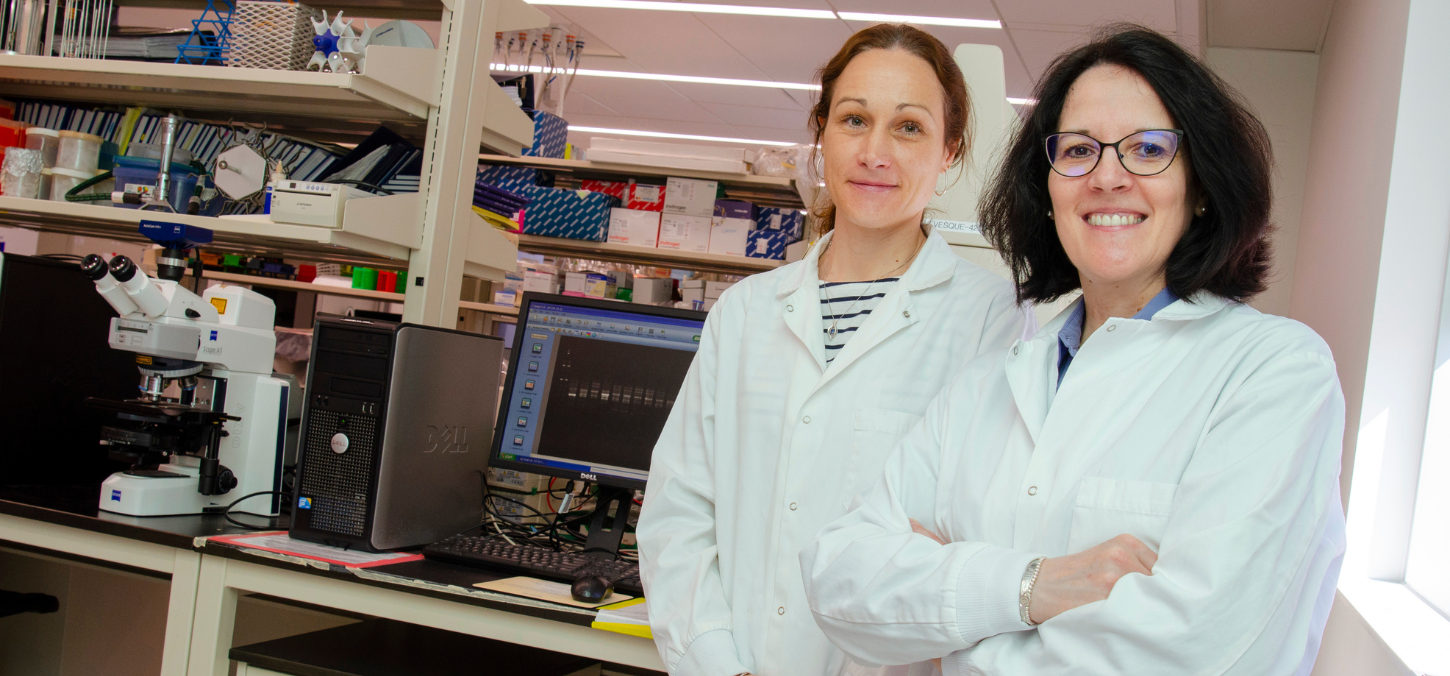Céline Lévesque (right) and Delphine Dufour are studying how bacteria in biofilms pick up and spread antimicrobial resistance. (Photo credit: Jeff Comber)
May 23, 2023
By Nina Ambros
Today over sixty-five per cent of human infections are due to bacterial infections. Antibiotic resistance, when bacteria can defeat the drugs designed to kill them, is a serious health problem and remains a top concern for many clinicians and researchers.
That’s why Céline Lévesque’s lab has been studying how bacteria are able to survive in different conditions. Recently, together with senior research associate Delphine Dufour, they found that bacteria can pass on antibiotic-resistant DNA to other cells in the mouth. Although Lévesque’s research heavily focuses on Streptococcus mutans (the bacteria responsible for cavities), their recent findings have implications that go well beyond oral health.
Understanding how bacteria behave
Bacterial cells do not like to be on their own. They always attach to a surface, and group together to form a biofilm. In this biofilm, they exist amongst different bacterial species. To communicate, bacteria can secrete and sense chemicals in their surroundings through receptors on their surface. This is called “quorum sensing” and it’s the way that bacteria ‘talk’ to each other, detect stressors and protect themselves.
“When the antibiotic treatment is done, the persisters wake up and repopulate the bacterial film.”
When studying antibiotic resistance, Lévesque’s lab noticed that certain individual bacterial cells would go into a dormant state in the presence of an antibiotic. These ‘persisters’ would reduce their metabolic activity and become dormant as a protection mechanism. “When they are dormant this makes them tolerant to antibiotics. When the antibiotic treatment is done, the persisters wake up and repopulate the film. This ‘resuscitation’ leads to chronic infections that are hard to heal.” says Lévesque, who is a professor in the Faculty of Dentistry and a member of the U of T-based Emerging and Pandemic Infections Consortium.
How are persisters formed?
These ‘persisters’ make up around one percent of the total bacterial film. How are these antibiotic-tolerant cells formed? Lévesque knew that in the biofilm environment, bacteria secrete different substances that they can pass on to each other, including DNA. Was it possible that persisters can pick up this free-floating DNA and become true antibiotic resistant cells?
Together with Dufour, they found that persisters could indeed bind DNA that they pick up in the biofilm environment. If this DNA encodes antibiotic resistance genes, the bacteria acquire this resistance. They discovered that because of this ability, these sleeping bacteria can catch what is around them, and when they wake up, they have a new addition to their genome. Lévesque and Dufour wanted to take it a step further and see if persisters were able to pass on this antibiotic- resistant DNA to other cells in the mouth. They found that when persisters wake up after the antibiotic treatment is done, they can share their DNA with cells around them and the entire new biofilm can become resistant.
“This is a significant discovery because if persisters of Streptococcus mutans have this function, it is highly likely that other bacteria species in the genus also have it, which has implications for many other chronic infections beyond the mouth” says Dufour.
Fighting antibiotic resistance
The ability of persisters to pick up and spread antibiotic-resistant DNA is regulated by quorum sensing. To prevent persister formation, scientists are looking at ways of preventing this bacterial communication.
“What can we do to stop this? We can block their communication system.”
When antibiotics alone are not enough anymore, quorum sensing inhibitors would be a way to deal with antibiotic tolerance and prevent persister formation. “For example, in addition to an antibiotic, you can administer a molecule to bind to the receptor of a bacteria to prevent these quorum sensing receptors from binding.” says Dufour.
Dufour’s work on the DNA acquisition of antibiotic resistance genes by Streptococcus mutans persisters won the 1st place in the Post-Doctoral Fellows/Research Associate Category at Research Day 2023. Look out for their new publication coming in fall 2023.
This story was originally published on the Faculty of Dentistry website.


